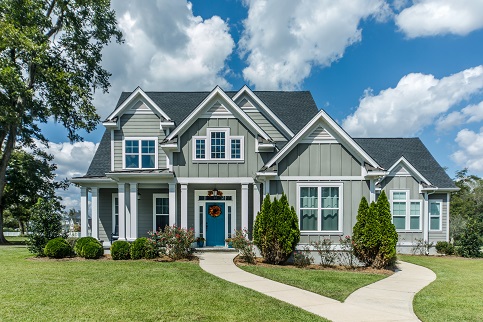Ginnie Mae plays an important role in the affordability of certain loan programs involved with the Federal Housing Administration (FHA), Department of Veterans Affairs (VA), and U.S. Department of Agriculture (USDA). Without it, these agencies wouldn’t be able to offer the flexible guidelines they have, making it much more difficult to find affordable housing.
Let’s take a closer look at what Ginnie Mae is, how it works and the benefits this organization offers home buyers.
What Is The Government National Mortgage Association (GNMA)?
The Government National Mortgage Association, also called Ginnie Mae, is a federally owned corporation that helps guarantee homes for low-income borrowers and first-time home buyers.
Founded from the privatization of Fannie Mae, Ginnie Mae doesn’t originate or underwrite loans. Instead, it guarantees mortgages on single-family and multifamily properties, making it more affordable for low-income families to secure financing.
See What You Qualify For
Buy A Home
Discover mortgage options that fit your unique financial needs.

Refinance
Refinance your mortgage to have more money for what matters.
Tap Into Equity
Use your home’s equity and unlock cash to achieve your goals.
How Does Ginnie Mae Work?
Ginnie Mae was created to help Americans get access to more affordable mortgage loans. It accomplishes this through the following two functions.
Guaranteeing Government Loans
Ginnie Mae guarantees U.S. government loans so that lenders and investors take on less risk. Because of this, lenders can offer more appealing rates and more flexible qualifying factors to home buyers.
Ginnie Mae also mitigates risk for mortgage investors to increase liquidity in the mortgage market. In other words, when lenders don’t have to hold onto mortgages and can instead sell them on the secondary market, it frees up more capital, allowing them to write more mortgages.
Issuing Mortgage-Backed Securities
Ginnie Mae also helps keep liquidity in the mortgage market by guaranteeing and issuing certain mortgage-backed securities (MBSs). MBSs are a pool of similar mortgages sold on the secondary market to free up a lender’s capital and allow them to underwrite more loans.
GNMA is able to do this by functioning as a bond issuer. This means that it purchases government-backed mortgages from financial institutions and packages them into Ginnie Mae MBSs before reselling the bonds on the secondary mortgage market.
It’s also important to note that Ginnie Mae operates under the blanket of the Department of Housing and Urban Development (HUD), along with other government agencies, such as the FHA, VA and USDA.
Find A Mortgage Today and Lock In Your Rate!
Get matched with a lender that will work for your financial situation.
What Are The Advantages Of Ginnie Mae Loans?
As mentioned previously, the guarantee Ginnie Mae offers gives banks additional liquidity, allowing them to be more flexible with their underwriting guidelines. This, in turn, means lenders can accept loans from borrowers with less-than-perfect credit and still offer lower interest rates because of the guarantee.
Borrowers without large down payments, perfect credit or low debt-to-income ratios – who might not have qualified for a conventional home loan – can secure a mortgage backed by a government agency.
The guarantee also helps many first-time home buyers by providing them with a more affordable mortgage through a government loan. For example, FHA loans are a popular option for many first-time homeowners because of their less strict credit score and down payment requirements. You can get an FHA mortgage with as little as 3.5% down and a credit score of 580 or higher.
Ginnie Mae Vs. Fannie Mae And Freddie Mac
Ginnie Mae, Fannie Mae and Freddie Mac have some similarities, and they’re all important pieces of the puzzle in the mortgage industry. Home affordability decreases when any of the three agencies decline, making it much harder for low-income families to buy homes.
Despite their similarities, Ginnie Mae, Fannie Mae and Freddie Mac have many differences too:
Ginnie Mae Vs. Fannie Mae And Freddie Mac
Ginnie Mae | Fannie Mae | Freddie Mac | |
|---|---|---|---|
Ownership | Owned by HUD | Owned by shareholders | Owned by shareholders |
Oversight | Regulated by the government | Regulated by the government | Regulated by the government |
Loan Securitization | Buys government loans | Buys conforming loans | Buys conforming loans |
Ownership
HUD, a government organization, owns Ginnie Mae. Fannie Mae and Freddie Mac are publicly traded organizations. That means shareholders own Fannie Mae and Freddie Mac, whereas the government owns and runs Ginnie Mae.
Fannie Mae (also known as the Federal National Mortgage Association) and Freddie Mac (also called the Federal Home Loan Mortgage Corporation) are government-sponsored enterprises (GSEs) that create guidelines for the loans they guarantee. Loans that meet their guidelines become bundled and bought by Fannie Mae or Freddie Mac to provide more liquidity for lenders.
Ginnie Mae guarantees certain mortgages from organizations like the FHA and USDA, but they don’t buy the MBSs like GSEs do.
Oversight
Even though they’re privately owned and aren’t considered government agencies, Fannie Mae and Freddie Mac are heavily monitored and regulated by the government. On the other hand, Ginnie Mae is a government branch and is controlled by HUD.
Loan Securitization
Ginnie Mae’s securitization model guarantees mortgage-backed securities. This means Ginnie Mae covers a part of the lender’s losses if a borrower stops making payments. This guarantee entices more investors, making the mortgage market more liquid.
Unlike Ginnie Mae, Fannie Mae and Freddie Mac take it a step further. They buy the loans lenders underwrite that meet their guidelines. Ginnie Mae only guarantees a portion of the payments, whereas Fannie and Freddie purchase the loans.
Fannie Mae and Freddie Mac buy conforming mortgages, while Ginnie Mae only deals with government loans.
Are GNMA Bonds A Good Investment?
As investors look for a more diversified investment option that pays higher rates than CDs or money market funds, GNMA bonds are becoming more popular.
Of course, like any investment, there is always an interest rate risk. If the Federal Reserve increases the federal funds rate, Ginnie Mae’s rates of return fall, and vice versa. There is also a small risk of default, as is the case for almost any investment; however, the risk is so small that it’s not something most investors consider.
Another downside, however, is the high minimum investment requirement. For example, most GNMA bonds require a minimum investment of $25,000. So it might not be worth it if you don’t have enough money to invest in GNMA bonds.
To determine whether these are a good investment based on your situation and financial goals, it’s best to speak to a financial advisor.
FAQ
Ginnie Mae loans have many benefits. Here are some of the most common questions about them.
The Bottom Line
Ginnie Mae is an important part of the mortgage market. Without their guarantee, there would be much less demand for mortgage-backed securities, decreasing lenders’ liquidity and making it much harder to secure a mortgage.
Even though seeing how or why mortgages are sold to investors isn’t necessary for you to get a mortgage, understanding how the process works can help you understand why there are strict requirements when borrowing a mortgage.
See What You Qualify For
You can get a real, customizable mortgage solution based on your unique financial situation.

Sam Hawrylack
Samantha Hawrylack is a full-time personal finance and real estate writer with five years of experience. She has a bachelor's degree in finance and an MBA from West Chester University. She writes for publications like BiggerPockets, Angi, Well Kept Wallet, Crediful, Clever Girl Finance, AllCards, InvestingAnswers and many more.












